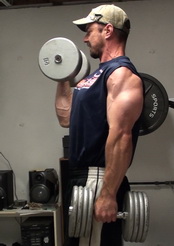Finding a resistance pattern that matches the strength curve of an exercise is an incredibly powerful way to maximize muscle growth and strength.
The best example of this is the bench press...you're weaker at the bottom and stronger at the top. This is easily remedied with reverse band bench press, where the bands stretch from the top, taking up weight at the bottom and decreasing the assistance as you come to the top where you're stronger.
Entire lines of exercise machines are designed around this strength curve concept, including Nautilus and Hammer Strength (with varying degrees of success).
Because without this adaptation, you can only use as much on the full lift as you can handle in the very WEAKEST point of the exercise.
This underloads the rest of the entire range of motion.
The back is a tough one to match strength curves with free weight movements.
For example, when doing a normal pulldown, you're stronger in the top half of the range of motion. Once your upper arms pass the 90 degree mark, your leverage gets weaker and you can't move as much weight with good form.
Therefore, when doing the exercise properly, you can only use as much weight as you can handle in the BOTTOM, weaker part of the range of motion.
That's why you often see people heaving themselves backwards to use momentum to get the weight down to that bottom position where they normally couldn't get to without the heave. They could do it in the top half, but can't get it past the 90 degree point.
The main problem with finding free weight back exercises to match this type of strength curve is gravity. It's easy in the press because gravity works in your favor in terms of bands to assist.
The pulldown, or pull-up for that matter, is the opposite. If you add bands, you end up ADDING resistance where you actually want to REDUCING resistance.
It's been a "white whale" of mine to find a way to actually match the strength curve of the pulldown with resistance.
And I found it...
This is The Strength Curve One-Arm Pulldown...
(I'm creative in exercises, not exercise names :)
To do this one, all you need is a normal pulldown high pulley and a normal pulldown bar... NO special equipment required (which is one of my requirements for finding a good technique).
Start with a light weight until you get the hang of the movement.
Turn the handle 90 degrees to where you'd normally have it. Grip by the bend with an UNDERHAND grip with your left hand and near the bend on the other end with an OVERHAND grip with your right hand.
You can adjust these grips as needed once you do the exercise.

Here's the key...
Your LEFT hand is going to be the PIVOT point of the pulldown. You want to keep your left hand right beside your head for the entire movement, just like it's nailed into your skull.
The bar will be angled up.

Now use your right arm to pull the other end of the bar down. This is the stronger part of the range of motion. This loading is heavier because you're pulling the cable basically straight down through this range.

Now for the genius part of this exercise...
Once your upper arm passes about the 90 degree mark, your "left hand pivot point" causes you to pull down in an ARC, bringing your elbow towards your side.
This is easier to see in the video above.

The cable is now being pulled at an ANGLE instead of straight down, reducing the resistance on the lats during their weaker phase of the movement.
This is the EXACT match of the strength curve of the pulldown - more resistance at the top, less at the bottom.
Now, you will notice that your left upper arm will get WORKED here, too (primarily the brachialis and the grip). I haven't yet found a way to effectively get around that and I did try.
This means you will want to take a rest before you work the other side, otherwise it will compromise your strength on the exercise on the other side.
When you're ready, grip underhand with the right arm and overhand with the left arm. Get a good stretch on the lats at the top.

And do the pulldown, just like you did before.

When you hit that 90 degree mark, the "hand pivot" brings the bar end down and in.

You'll notice when I do the exercise, I sometimes lean to the side a bit. I didn't find this to be a problem in terms of lat contraction and overall work. It just naturally happened as I was working the exercise.
When coming down into the bottom, come down just until your upper arm is vertical. You don't need to pull the elbow behind the body as that brings in other muscles and doesn't work the lats any further.
How To Use Strength Curve One-Arm Pulldowns In a Workout
I like this one for moderate reps...5-8 reps is a good range. You want to use enough weight that your lats really feel it but not so much that you start having to use momentum. We want the MUSCLE to do the work here. And going too light will diminish the effectiveness of the first half of the movement.
I would suggest 3-4 sets on each side for volume.
You can use this one pretty much wherever you like in a back workout, however it will definitely fatigue your lats if you're planning on doing "performance" type exercises like chin-ups for specific reps.
---
Are you 40...50...60 or even 70+ years old and want to build muscle and strength like you did 20 years ago?
If you feel like you're fighting a losing battle, you're ready to discover the REAL secret to REVERSING muscle loss due to aging...
*** You need to train the body systems that SUPPORT your muscle mass, not just the muscle itself. ***
These underlying support systems diminish as you age, which is why you lose muscle as you get older no matter how hard you train... but with strategic training, these systems can be regenerated.
Share This Page...
Want More Exercises Like This?
You'll find them here...



